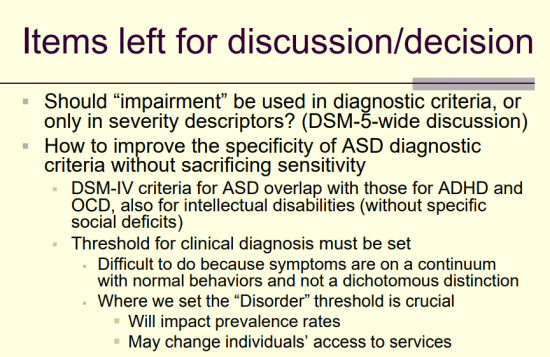PDD-NOS stands for Pervasive Developmental Disorder–Not Otherwise Specified. Once upon a time, doctors diagnosed PDD-NOS when symptoms didn’t quite fit the picture of plain old Pervasive Developmental Disorder (PDD), itself something of a wastebasket term. Now, neither term is in use.
Back in the day, PDD served as an umbrella for five disorders: Autism, Asperger’s syndrome, Childhood Disintegration Disorder (CDD), and Rett’s syndrome. But the authors of the most recent edition of the Diagnostic and Statistical Manual of Mental Disorders (DSM) decided to broaden the wastebasket and do away with most of these terms and their subcategories. Going forward, doctors will no longer diagnose “Asperger’s syndrome,” for instance, but simply say someone has an Autism Spectrum Disorder (ASD).
When the DSM-5 came out, and even in the lead-up to its publication, a lot of people were upset. All of a sudden, people who had Asperger’s no longer had it. Instead, they simply had plain old autism. And people with PDD-NOS either had autism or something new called Social Communication Disorder (SCD).
Now most people, when they think of autism, think of a syndrome that is severe in nature. Asperger’s syndrome, on the other hand, tends to be thought of as being “almost normal” and maybe even quirky, cute, or interesting, in a geeky sort of way. If you’ve ever watched Criminal Minds on television, Dr. Spencer Reid is the perfect example of how people like to see Asperger’s. He’s lovable because he’s so awkward with people and yet so wide open and real. He’s a genius, a nerd. He’s interesting, upper class, a kind of savant.
Some of us, when we think of Asperger’s, imagine something that causes mildly embarrassing confrontations in the supermarket, like the sort of thing that happens with Max Braverman in Parenthood. There’s angst, but also joy, and perhaps even social justice to the act of parenting a child like Max.
You might even say that Asperger’s syndrome is in vogue as the cool kind of autism. So, if you’re a (white and wealthy) parent of a child with High-Functioning Autism (HFA), you’d probably much rather hear a diagnosis of Asperger’s than of HFA, or at least your doctor might assume so and perhaps respond accordingly. The doctor’s thinking you’d rather parent Max than Dustin Hoffman’s Raymond in Rain Man.
By the same token, if you’re poor and black and your child had exactly those same symptoms, it’s likely the doctor, prior to 2013, would have simply said your child had autism or perhaps even PDD-NOS. There’s a problem here of consistency. There’s also a problem of mixing diagnostic boxes.
HFA was interchangeable with Asperger’s and PDD-NOS was interchangeable with autism. It all depended on a doctor’s cultural biases or on how sure he was about that diagnosis: were the signs and symptoms really “bad enough” to be autism? There is an issue here of sacrificing specificity for sensitivity’s sake so the doctors (pre-DSM-5) kept the definitions vague to prevent anyone from feeling too bad. They avoided the stigma of calling someone “autistic” if they thought you might get upset.

PDD-NOS “Less Severe”
But since Asperger’s and PDD-NOS were deemed syndromes “less severe” than autism, 14 states didn’t offer access to services for people with these diagnoses. While Asperger’s was the cute and cuddly white person’s autism, PDD-NOS covered anything that didn’t quite fit the autism diagnosis, for instance Asperger’s. PDD-NOS could, for instance, be very mild autism. It was all a matter of perspective, rather than hard science.
What the DSM-5 attempted to do, in eliminating these terms, and in making the listing for autism more broadly inclusive, was address this inherent bias, and make it possible for more people to receive much-needed services.
But what happens to someone who has always thought of himself as having Asperger’s? It’s his identity. Suddenly you take it away and he’s now “autistic?” (Ow. That bites.)
Except it doesn’t.
According to the Autism Speaks website, people can still call themselves what they always did. In fact, psychologists are allowed to designate “Asperger’s” as the type of autism a person has when writing up an evaluation or diagnosis, alongside the new diagnostic term autism spectrum disorder:
Many individuals may wish to retain their previous diagnosis as the label is considered part of their identity or may reflect a peer group with whom they identify. This is perfectly acceptable. A clinician can indicate both the DSM-5 diagnosis as well as the previous diagnosis, such as Asperger syndrome, in an individual’s clinical record.
The DSM-5 text states “Individuals with a well-established DSM-IV [diagnosis] of autistic disorder, Asperger’s disorder, or pervasive developmental disorder not otherwise specified should be given the diagnosis of “autism spectrum disorder.”
The bottom line is that nothing has really changed except for the fact that more people on the autism spectrum can get the services they deserve. Meantime, there’s the hope that bias and stigma can be excluded from the diagnostic process for autism spectrum disorders. The new DSM-5 classification signifies that it’s time to stop worrying about how things look. Going forward, we are putting that energy toward helping people with the challenges they face.
By now we’re all hopefully evolved enough to see that autism can happen to anyone. We know that having autism has nothing to do with what color you are or how much money you have. This being the case, what the DSM-5 does is shove these outmoded ideas to the side, allowing us to concentrate on early diagnosis and creating more treatment options.
Because that is how things should be in an ideal world.
Found what you just read useful? Why not consider sending a donation to our Kars4Kids youth and educational programs. Or help us just by sharing!
Editor’s note: This post was originally published June 24, 2015 and has been completely revised and updated for accuracy and scope.
